
Primula is a genus of mainly herbaceous flowering plants in the family Primulaceae. They include the familiar wildflower of banks and verges, the primrose. Other common species are P. auricula (auricula), P. veris (cowslip) and P. elatior (oxlip). These species and many others are valued for their ornamental flowers. They have been extensively cultivated and hybridised - in the case of the primrose, for many hundreds of years. Primula are native to the temperate northern hemisphere, south into tropical mountains in Ethiopia, Indonesia and New Guinea, and in temperate southern South America. Almost half of the known species are from the Himalayas.

Schizophragma, the hydrangea vine, is a genus of four species of flowering plants in the family Hydrangeaceae, native to moist woodland in Asia, from the Himalayas east to Taiwan and Japan. They are vigorous, hardy deciduous lianas growing to 12 m (39 ft), cultivated for their showy flower heads borne in mid- to late summer, resembling those of the related lacecap hydrangeas.

Delphinium is a genus of about 300 species of perennial flowering plants in the family Ranunculaceae, native throughout the Northern Hemisphere and also on the high mountains of tropical Africa. The genus was erected by Carl Linnaeus.

Sempervivum is a genus of about 40 species of flowering plants in the family Crassulaceae, commonly known as houseleeks. Other common names include liveforever and hen and chicks, a name shared with plants of other genera as well. They are succulent perennials forming mats composed of tufted leaves in rosettes. In favourable conditions they spread rapidly via offsets, and several species are valued in cultivation as groundcover for dry, sunny locations.
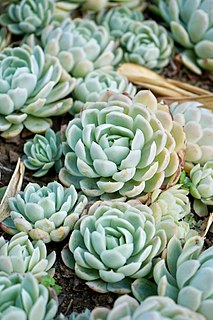
Echeveria is a large genus of flowering plants in the family Crassulaceae, native to semi-desert areas of Central America, Mexico and northwestern South America.

Polygonatum multiflorum, the Solomon's seal, David's harp, ladder-to-heaven or Eurasian Solomon's seal, is a species of flowering plant in the family Asparagaceae, native to Europe and temperate Asia. In Britain it is one of three native species of the genus, the others being P. odoratum and P. verticillatum.
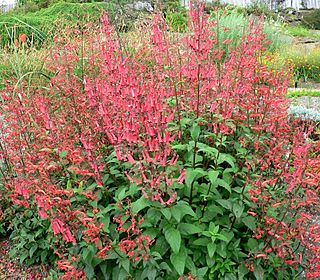
Phygelius, common names Cape fuchsia or Cape figwort, is a genus of flowering plants in the family Scrophulariaceae, native to wet slopes and banks in southern Africa. They are evergreen shrubs often treated as perennials in colder climates. They bear many pendent tubular flowers over a long period in summer, in shades of white, yellow and red. The vague similarity of the blooms to fuchsias has led to the common name Cape fuchsia, though they are not closely related.

Callicarpa bodinieri, or Bodinier's beautyberry, is a species of flowering plant in the genus Callicarpa of the family Lamiaceae, native to West and Central China. Growing to 3 m (10 ft) tall by 2.5 m (8 ft) wide, it is an upright deciduous shrub with dark green leaves turning red in autumn (fall). In midsummer, small lilac flowers are produced in the leaf axils. But it is grown in gardens primarily for its small, decorative purple berries in tight clusters in autumn. While the berries are not poisonous, they are very bitter. Wildlife will not eat them until there are no other available food sources. This species is more tolerant of cold than C. americana.
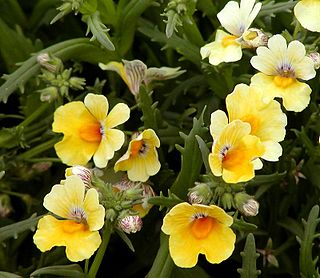
Nemesia is a genus of annuals, perennials and sub-shrubs which are native to sandy coasts or disturbed ground in South Africa. Numerous hybrids have been selected, and the annual cultivars are popular with gardeners as bedding plants. In temperate regions they are usually treated as half-hardy, grown from seed in heat, and planted out after all danger of frost has passed.

Malus transitoria, the cut-leaf crabapple, is a species of flowering plant in the crabapple genus Malus of the family Rosaceae, native to China.

Ranunculus aconitifolius, the aconite-leaf buttercup or bachelor's buttons, is a species of flowering plant in the buttercup family Ranunculaceae, native to central Europe. Growing to 60 cm (24 in) high by 40 cm (16 in) broad,it is an herbaceous perennial with slightly hairy palmate leaves up to 20 cm (8 in) long, and loose panicles of white, saucer-shaped flowers in spring.

Narcissus jonquilla, commonly known as jonquil or rush daffodil, is a bulbous flowering plant, a species of the genus Narcissus (daffodil) that is native to Spain and Portugal but has now become naturalised in many other regions: France, Italy, Turkey, the former Yugoslavia, Madeira, British Columbia in Canada, Utah, Illinois, Ohio, and the southeastern United States from Texas to Maryland.
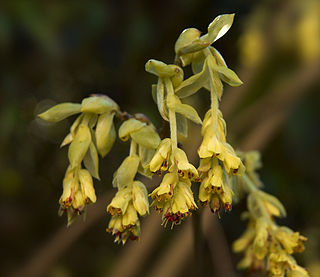
Corylopsis pauciflora, the buttercup witch hazel or winter hazel, is a species of flowering plant in the genus Corylopsis of the family Hamamelidaceae, native to Taiwan and Japan. It is a deciduous, spreading shrub growing to 1.5 m tall by 2.5 m wide. It produces masses of pale yellow flowers in pendent racemes in early spring, followed by leaves opening bronze and turning to rich green. It is cultivated in gardens and parks in temperate regions.
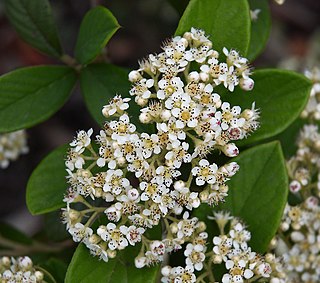
Cotoneaster lacteus, the late cotoneaster or milkflower cotoneaster, is a species of flowering plant in the genus Cotoneaster of the family Rosaceae, native to the Yunnan Province of China. It is a large evergreen shrub growing to 4 m (13 ft) tall and wide. Clusters of white flowers are followed by masses of small, globose, red fruits (pomes) in autumn. Unusually for this genus, the fruits are avoided by birds, hence garden escapes are rare, and the fruit persists on the plant throughout the winter.

Crocus speciosus, with common name Bieberstein's crocus, is a species of flowering plant in the genus Crocus of the family Iridaceae. The plant is native to northern and central Turkey, the Caucasus, northern Iran, Crimea.
- Crocus speciosus subsp. ilgazensisB.Mathew - Turkey
- Crocus speciosus subsp. speciosus - Turkey, Iran, Caucasus, Crimea
- Crocus speciosus subsp. xantholaimosB.Mathew - Sinop Province in Turkey

Eucryphia glutinosa, the brush bush or nirrhe, is a species of flowering plant in the family Cunoniaceae, native to moist woodland habitats in Chile. It is a large deciduous shrub or small tree, growing to 10 m (33 ft) tall by 6 m (20 ft) wide, with glossy dark green leaves turning red in autumn. Single four-petalled, fragrant white flowers with prominent stamens appear in late summer.

Physoplexis comosa, the tufted horned rampion, is a species of flowering plants in the family Campanulaceae, native to alpine Europe. It is the only species in its genus, and was formerly included in Phyteuma.
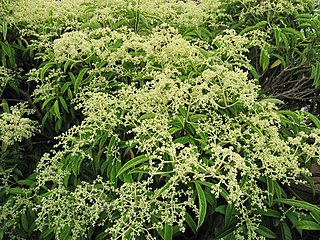
Pileostegia viburnoides, the climbing hydrangea, is a species of flowering plant in the family Hydrangeaceae, native to India and eastern Asia. It is a slow-growing, self-clinging, evergreen climber eventually growing to 6 m (20 ft) in length, with long narrow leaves and dense panicles of creamy white flowers in late summer.

Rehmannia elata, the Chinese foxglove, is a species of flowering plant in the family Orobanchaceae, native to China. Growing to 150 cm (59 in) tall by 50 cm (20 in) broad, it is an herbaceous perennial with veined, hairy leaves and pink, tubular flowers with darker pink stripes in summer. The flowers bear a superficial resemblance to foxgloves, hence the common name "Chinese foxglove", which is also applied to the whole genus. However this species is not closely related to the true foxglove (Digitalis).
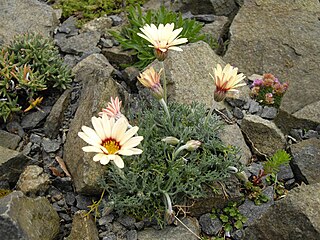
Rhodanthemum syn. Chrysanthemopsis, Pyrethropsis, is a genus of flowering plants in the family Asteraceae, mostly native to exposed rocky places in Northern Africa. Formerly included in either Chrysanthemum or Leucanthemum, the 10 or 15 species of Rhodanthemum display many similarities to their former congeners, with composite daisy-like flowers. They are mat-forming, prostrate perennials or subshrubs, and some are cultivated as ornamental plants.




















